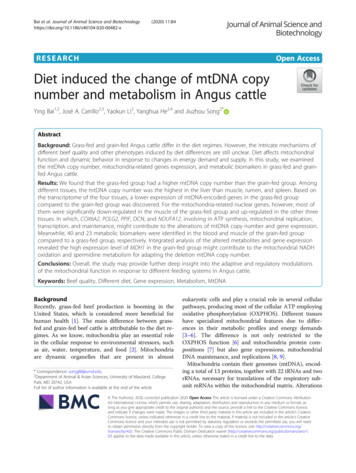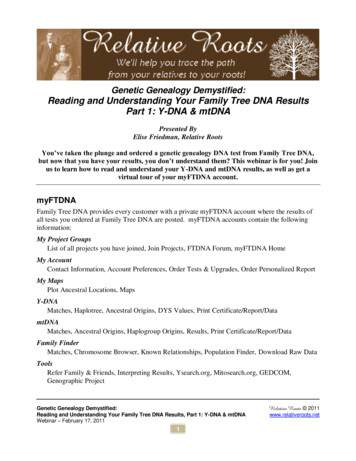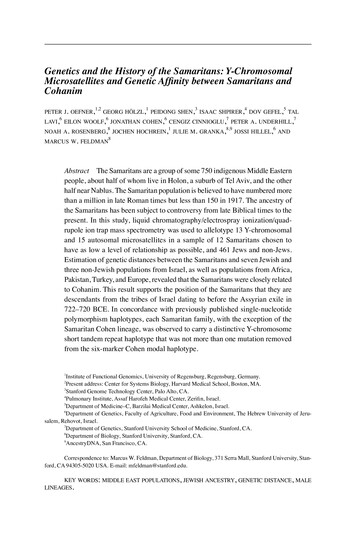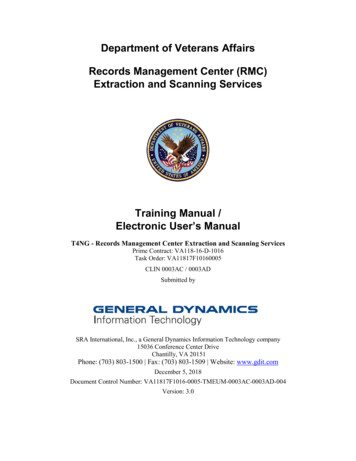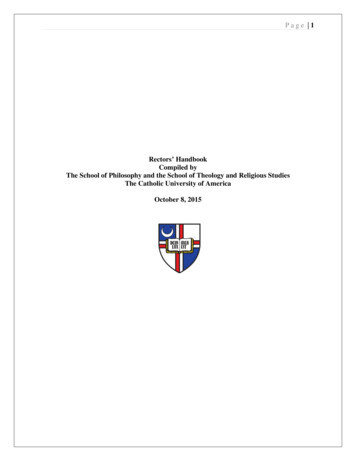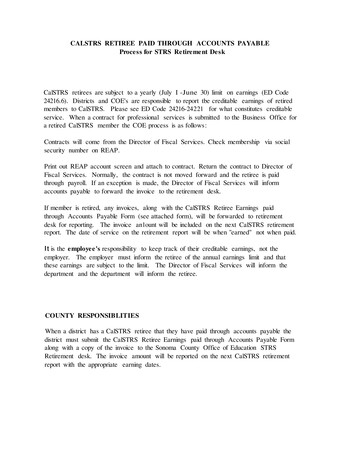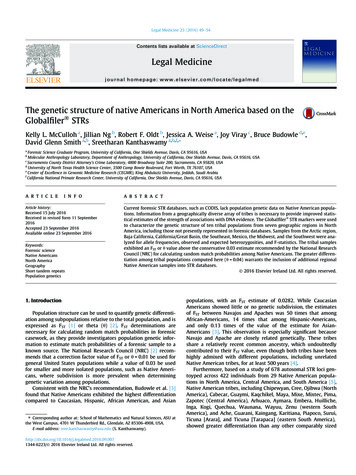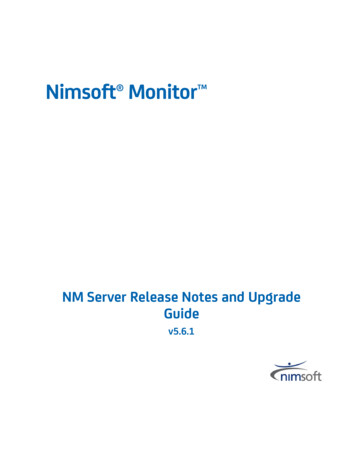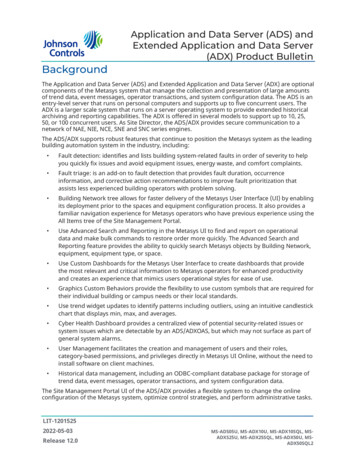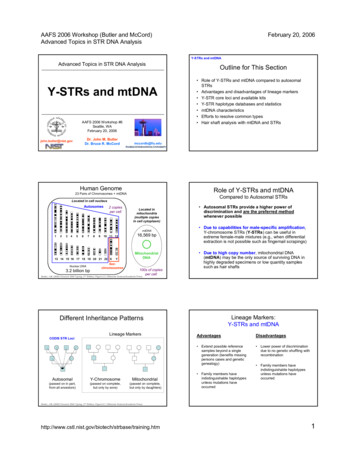
Transcription
AAFS 2006 Workshop (Butler and McCord)Advanced Topics in STR DNA AnalysisFebruary 20, 2006Y-STRs and mtDNAAdvanced Topics in STR DNA AnalysisY-STRs and mtDNAAAFS 2006 Workshop #6Seattle, WAFebruary 20, 2006Dr. John M. ButlerDr. Bruce R. McCordjohn.butler@nist.govHuman GenomeRole of Y-STRs and mtDNACompared to Autosomal STRsLocated in cell nucleushttp://www.ncbi.nlm.nih.gov/genome/guide/2 copiesper cellLocated inmitochondria(multiple copiesin cell cytoplasm)mtDNA12345678910 11 1213 14 15 16 17 18 19 20 21 22 XNuclear DNA3.2 billion bpYSexchromosomes Role of Y-STRs and mtDNA compared to autosomalSTRs Advantages and disadvantages of lineage markers Y-STR core loci and available kits Y-STR haplotype databases and statistics mtDNA characteristics Efforts to resolve common types Hair shaft analysis with mtDNA and STRsmccordb@fiu.edu23 Pairs of Chromosomes mtDNAAutosomesOutline for This Section16,569 bpMitochondrialDNA100s of copiesper cell Autosomal STRs provide a higher power ofdiscrimination and are the preferred methodwhenever possible Due to capabilities for male-specific amplification,Y-chromosome STRs (Y-STRs) can be useful inextreme female-male mixtures (e.g., when differentialextraction is not possible such as fingernail scrapings) Due to high copy number, mitochondrial DNA(mtDNA) may be the only source of surviving DNA inhighly degraded specimens or low quantity samplessuch as hair shaftsButler, J.M. (2005) Forensic DNA Typing, 2nd Edition, Figure 2.3, Elsevier Science/Academic PressLineage Markers:Y-STRs and mtDNADifferent Inheritance PatternsLineage MarkersCODIS STR LociAutosomalY-ChromosomeMitochondrial(passed on in part,from all ancestors)(passed on complete,but only by sons)(passed on complete,but only by daughters)AdvantagesDisadvantages Extend possible referencesamples beyond a singlegeneration (benefits missingpersons cases and geneticgenealogy) Lower power of discriminationdue to no genetic shuffling withrecombination Family members haveindistinguishable haplotypesunless mutations haveoccurred Family members haveindistinguishable haplotypesunless mutations haveoccurredButler, J.M. (2005) Forensic DNA Typing, 2nd Edition, Figure 9.1, Elsevier Science/Academic ning.htm1
AAFS 2006 Workshop (Butler and McCord)Advanced Topics in STR DNA AnalysisY-STRs permit extension of possible referencesamples in missing persons casesFebruary 20, 2006Historical Investigation of Jefferson-Hemings DNAThomas Jefferson IIField JeffersonPeter JeffersonGenetic Genealogy CompaniesPresidentThomas Jefferson?Eston Hemingsuncle?3rd cousin(paternal)JeffersonY HaplotypeJeffersonY HaplotypendButler, J.M. (2005) Forensic DNA Typing, 2Edition, Figure 9.3, Elsevier Science/Academic PressThomas WoodsonSame YHaplotypeDifferent Y HaplotypeSOURCE: Foster et al. (1998) Nature 396:27-28Figure 9.10, J.M. Butler (2005) Forensic DNA Typing, 2nd Edition 2005 Elsevier Academic Press(From Nature website)Value of Y-Chromosome MarkersJ.M. Butler (2005) Forensic DNA Typing, 2nd Edition; Table 9.1ApplicationAdvantageTHE HUMAN Y CHROMOSOME:AN EVOLUTIONARY MARKERCOMES OF AGEMark A. Jobling & Chris Tyler-SmithForensic casework onMale-specific amplification (can avoid differentialsexual assault evidence extraction to separate sperm and epithelial cells)Nature Reviews Genetics (2003) 4, 598-612AbstractPaternity testingMale children can be tied to fathers in motherlesspaternity casesMissing personsinvestigationsPatrilineal male relatives may be used forreference samplesHuman migration andevolutionary studiesLack of recombination enables comparison of maleindividuals separated by large periods of timeHistorical andgenealogical researchSurnames usually retained by males; can make linkswhere paper trail is limitedTraits found on the Y - ChromosomeAn Early Y-Chromosome Map spitting incessant use of TV remote buttons if lost, cannot stop and ask fordirections ability to recall facts aboutbaseball/basketball/hockey/golf/etc. male pattern baldness congregates with other Ychromosome bearers to do “guythings” Source of “Testosterone poisoning”10,000X magnificationof X and Y chromosomes Until recently, the Y chromosome seemed to fulfill therole of juvenile delinquent among humanchromosomes — rich in junk, poor in useful attributes,reluctant to socialize with its neighbors and with aninescapable tendency to degenerate. The availabilityof the near-complete chromosome sequence, plusmany new polymorphisms, a highly resolvedphylogeny and insights into its mutation processes,now provide new avenues for investigating humanevolution. Y-chromosome research is growing up.What has happened in the past few years “Full” Y-chromosome sequence became available inJune 2003; over 200 Y-STR loci identified (only 20 in 2000) Selection of core Y-STR loci (SWGDAM Jan 2003) Multiple commercial Y-STR kits released– Y-PLEX 6,5,12 (2001-03), PowerPlex Y (9/03), Yfiler (12/04) Many population studies performed and databasesgenerated with thousands of Y-STR haplotypes Forensic casework demonstration of value of Y-STRtesting along with court acceptanceScience (1993) aining.htm2
AAFS 2006 Workshop (Butler and McCord)Advanced Topics in STR DNA AnalysisDisadvantages of the Y-Chromosome Loci are not independent of one another andtherefore rare random match probabilities cannot begenerated with the product rule; must use haplotypes(combination of alleles observed at all tested loci) Paternal lineages possess the same Y-STRhaplotype (barring mutation) and thus fathers, sons,brothers, uncles, and paternal cousins cannot bedistinguished from one another Not as informative as autosomal STR results– More like addition (10 10 10 30) than multiplication(10 x 10 x 10 1,000)Scenarios Where Y-STRsCan Aid Forensic Casework Sexual assaults by vasectomized or azoospermic males (nosperm left behind for differential extraction) Extending length of time after assault for recovery ofperpetrator’s DNA profile (greater than 48 hours) Fingernail scrapings from sexual assault victimsFebruary 20, 2006Forensic Advantages of Y-STRs Male-specific amplification extends range of cases accessible toobtaining probative DNA results (e.g., fingernail scrapings, sexualassault without sperm) Technical simplicity due to single allele profile; can potentiallyrecover results with lower levels of male perpetrator DNA becausethere is not a concern about heterozygote allele loss via stochasticPCR amplification; number of male contributors can be determined Courts have already widely accepted STR typing, instrumentation,and software for analysis (Y-STR markers just have different PCRprimers) Acceptance of statistical reports using the counting method dueto previous experience with mtDNAY-STRs can permit simplification of male DNAidentification in sexual assault casesNo signal observedFemale VictimDNA ProfileMale PerpetratorDNA Profile Male-male mixtures Other bodily fluid mixtures (blood-blood, skin-saliva)DNA Profile fromCrime SceneAutosomal STRProfile Gang rape situation to include or exclude potential contributorsY-Chromosome STRProfileButler, J.M. (2005) Forensic DNA Typing, 2nd Edition, Figure 9.2, Elsevier Science/Academic PressPowerPlex Y Performance in Our HandsSelection of Core Y-STR Loci2 ng male2 ng male: 15 ng female500 pg male: 408 ng female800X female DNA1 ng male: 816 ng ining.htmSelectionSelection ofofU.S.U.S. CoreCore Loci:Loci:DYS19,DYS19,DYS385DYS385 DYS439DYS4393
AAFS 2006 Workshop (Butler and McCord)Advanced Topics in STR DNA Analysis11 PCR products9 primer setsFebruary 20, 2006Core Y-STR CharacteristicsSTR MarkerPosition(Mb)Repeat A)DYS385 a/bMulti-Copy (Duplicated) MarkerR primerR primerabF primerF primerDuplicated regions are40,775 bp apart and facingaway from each otherDYS43912.95AGAT8-150.38%DYS389 I/II13.05[TCTG] [TCTA]9-17 .71[TCTA] [TCTG]17-280.32%IIDYS385 a/b19.19,19.23GAAA7-280.23%F primerDYS39220.97TAT6-200.05%DYS389 I/II(B)Single Region but Two PCR Products(because forward primers bind twice)IDYS389IDYS389IIF primerPositions in megabases (Mb) along the Y-chromosome were determined with NCBI build 35 (May 2004)using BLAT. Allele ranges represent the full range of alleles reported in the literature. Mutation ratessummarized from YHRD (http://www.yhrd.org; accessed 6 Apr 2005).Butler, J.M. (2006) Genetics and genomics of core STR loci used in human identity testing. J. Forensic Sci., in press.a ba bR primerButler, J.M. (2005) Forensic DNA Typing, 2nd Edition, Figure 9.5, Elsevier Science/Academic PressAllele size range and locus dye colorsPromega PowerPlex Y Allelic LaddersPowerPlex YReleased by Promega Corporation in Sept 2003200 bp100 bpFLDYS391JOETMRDYS438300 bpDYS439DYS389IDYS437DYS393DYS19DYS390400 bpDYS391DYS389IDYS439DYS389IIDYS389II3 dye colors12-plex PCRDYS392DYS385a/bDYS438DYS437DYS19DYS392AmpFlSTR Yfiler Released by Applied Biosystems in Dec 2004200 bp100 bp6-FAMVICDYS456DYS389IDYS458NEDDYS393PETH4300 bpDYS390DYS19DYS391DYS390DYS385 a/bDYS389II4 dye colors17-plex PCRDYS385a/bDYS439DYS437DYS393400 bpDYS635DYS438DYS392U.S. Core Loci DYS437Single amplification; ladders contain 103 allelesDYS448Yfiler Allelic LaddersSubdividing Common Types with More Loci656 males from 3 U.S. populationsU.S. Core Loci DYS437, DYS448,DYS456, DYS458,DYS635, GATA H4Minimal haplotype(19, 389I/II, 390, 391, 392, 393, 385 a/b)(26)U.S. HaplotypeSWGDAM recommended loci ( 438,439)(7)(4)DYS19 – 14DYS389I – 13DYS389II – 29DYS390 – 24DYS391 – 11DYS392 – 13DYS393 – 13DYS385 a/b – 11,14(15)PowerPlex Y(2)Most common type(3)(1)Yfiler(1) (1)(1) (1)(1) (1) (1) (1)(4)( 437)(12)(1)(3)(1)(1) (1) (1)( 448,456,458,635,H4)(1) (1) (1)(1) (1) (1)(1) (1) (1) (3) (1) (1)Identical: DYS 444,446,485,495,505,508,534,540,556Subdivide into two groups (2)(1): DYS 449,463,520,532,533,557,570,594,643Subdivide into three groups (1)(1)(1): DYS522, ining.htm4
AAFS 2006 Workshop (Butler and McCord)Advanced Topics in STR DNA AnalysisNew Y-Chromosome InformationResources on STRBaseLocus boxes are e/y strs.htmto STR Fact SheetsFebruary 20, 2006Y-Chromosome Haplotype ReferenceDatabase (YHRD)Run only with minimal haplotypehttp://www.yhrd.orgAs of 12/5/05:Largest Y-STRDatabaseYHRD has9,634 haplotypes(from 61 populations)with SWGDAMrecommended loci34,558 haplotypes9,634 haplotypeswith all US required lociCommercial Y-STR kits exist to amplifyall of the core loci in a single reaction(plus a few additional 385 a/bUS haplotype requires2 additional loci:DYS438DYS439Haplotype Databases for Y-STR erPlex Y1311 Caucasians325 Asians894 Hispanics1108 African Americans366 Native Americans--------------4,004 total(as of March 2005)Yfiler1276 Caucasians330 Asians597 Hispanics985 African Americans106 Native Americans105 Filipino59 Sub-Saharan Africans103 Vietnamese---------------Statistics with Y-STRHaplotypesMost labs will probably go with thecounting method (number of times ahaplotype is observed in a database)as is typically done with mtDNA results3,561 total(as of December 2004)Example Y-STR HaplotypeY-Chromosome Haplotype Reference Databasewww.YHRD.org7 matches in 27,773individuals from 236worldwide populationsRelease "15" from 2004-12-17 16:11:24Core US HaplotypeMatches by Databases YHRD (9 loci)DYS19 – 14DYS389I – 13DYS389II – 29DYS390 – 24DYS391 – 11DYS392 – 14DYS393 – 13DYS385 a/b – 11,15DYS438 – 12DYS439 – 13– 7 matches in 27,773 YHRD (11 loci)– 0 matches in 6,281 ReliaGene (11 loci)– 0 matches in 3,403Minimal Haplotype ResultDYS19 – 14DYS389I – 13DYS389II – 29DYS390 – 24DYS391 – 11DYS392 – 14DYS393 – 13DYS385 a/b – 11,15 PowerPlex Y (12 loci)– 0 matches in 4,004 Yfiler (17 loci)– 0 matches in ning.htm5
AAFS 2006 Workshop (Butler and McCord)Advanced Topics in STR DNA AnalysisFrequency Estimate CalculationsUsing the Counting MethodIn cases where a Y-STR profile is observed a particular number of times(X) in a database containing N profiles, its frequency (p) can becalculated as follows:7 matches in 27,773p X/Np 7/27,773 0.000252 0.025%An upper bound confidence interval can be placed on the profile’sfrequency using:p 1.96( p)(1 p)N0.000252 1.96(0.000252)(1 0.000252)27,773February 20, 2006When there is no matchwith the counting method In cases where the profile has not been observed in a database,the upper bound on the confidence interval is1-α1/N0 matches in 4,004where α is the confidence coefficient (0.05 for a 95% confidenceinterval) and N is the number of individuals in the database.1-α1/N 1-(0.05)[1/4,004] 0.000748 0.075% ( 1 in 1340) 0.000252 0.000187 0.000439 0.044%( 1 in 2270)The Meaning of a Y-Chromosome MatchConservative statement for a match report:The Y-STR profile of the crime sample matchesthe Y-STR profile of the suspect (at xxxnumber of loci examined). Therefore, wecannot exclude the suspect as being thedonor of the crime sample. In addition, wecannot exclude all patrilineal related malerelatives and an unknown number ofunrelated males as being the donor of thecrime sample.If using database of 2,443, then the best you can do is 1in 816Difficult Questions Which database(s) should be used for Y-STRprofile frequency estimate determination? Are any of the current forensic Y-STR databases trulyadequate for reliable estimations of Y-STR haplotypefrequencies?– Some individuals share identical Y-STR haplotypes due torecurrent mutations, not relatedness – Is the database a random collection reflecting Y-STRhaplotype frequencies of the population?– Is the Y-STR haplotype frequency relevant for the populationof the suspect?Issues raised by Peter de Knijff at his Promega meeting presentation (Oct 2004)Conclusions from Peter de KnijffWhat Peter de Knijff Reports with a Y-STR MatchFrom his presentation at the Promega meeting (Oct 2004)From his presentation at the Promega meeting (Oct 2004)A haplotype frequency taken from any Y-STRdatabase should not be reported or seen as arandom match probability– Because all male relatives have the same haplotype– Males can share haplotypes without being relatedDatabase estimates are at most qualitative htm The Y-STR profile of the stain matches with the suspect. Therefore, the suspect cannot be excluded as the donor of thestain. On the basis of this DNA evidence, I can also not exclude allpaternally related male relatives of the suspect as possibledonors of this stain. In addition, an unknown number of males from the sameregion cannot be excluded. A more accurate answer can onlybe obtained if (1) we have detailed knowledge of the populationstructure of the region of interest, (2) the Y-STR frequenciestherein are known, and (3) we have knowledge about the familystructure of the suspect.6
AAFS 2006 Workshop (Butler and McCord)Advanced Topics in STR DNA AnalysisFebruary 20, 2006Can Y-STR results be combined withautosomal STR information?International Forensic Y-User Workshops Still subject to some debate among experts(most say “yes”) Next meeting (5th): Sept 26-30, 2006 (Innsbruck,Austria) – will also cover mtDNA Problem of different inheritance modes Multiply random match probability from theautosomal STR profile obtained with the upperbound confidence limit from the Y-STRhaplotype frequency estimate1st – Berlin, Germany June 19962nd – Berlin, Germany June 20003rd – Porto, Portugal Nov 20024th – Berlin, Germany Nov 2004For more information, see: http://www.yhrd.org/index.htmlMitochondrial DNA (mtDNA)Comparison of Nuclear and Mitochondrial DNAAdvantages of mtDNA testing:Higher copy number per cellResults with highly degraded DNAResults with limited sample (hair shaft)Disadvantages of mtDNA testing:Low power of discriminationLabor ckissu/july1999/dnaf1.htmIdentifying the Romanov Remains (the Last Russian ouise ofofHesse-CasselHesse-CasselControl region (D-loop)16024OHTGeorgijGeorgijRomanovRomanovHeavy (H)strandF 12SrRNAcyt b5762 6294T16296T73G263G315.1CPrincePrince PhilipPhilipDukeDuke ofof EdinburghEdinburghSOURCES: Gill et al. (1994) Nature Genetics, 6, 130-135.;Ivanov et al. (1996) Nature Genetics, 12, 417-420; Stone,R. (2004) Science, 303, 753.ndD.N.A. Box 10.2, J.M. Butler (2005) Forensic DNA Typing, 2Edition 2005 Elsevier Academic ning.htmQIMANND2“16,569” bpLight (L)strandND4XeniaXenia ionWND4LRND313 genes16SrRNA1/16,569PTsarNicholas II22 tRNAsCOICOIIIATP6ATP8KCOIIDndFigure 10.1, J.M. Butler (2005) Forensic DNA Typing, 2Edition 2005 Elsevier Academic Press7
AAFS 2006 Workshop (Butler and McCord)Advanced Topics in STR DNA AnalysisFebruary 20, 2006FBI A1 (L15997)Revised CambridgeReference SequenceGAAAAAGTCT TTAACTCCAC CATTAGCACC CAAAGCTAAG ATTCTAATTT AAACTATTCTCTTTTTCAGA AATTGAGGTG GTAATCGTGG GTTTCGATTC TAAGATTAAA TTTGATAAGAControl Region (16024-576)15970HV115980159901600016010(rCRS) – formerly known as16020the “Anderson” sequenceCTGTTCTTTC ATGGGGAAGC AGATTTGGGT ACCACCCAAG TATTGACTCA CCCATCAACAGACAAGAAAG TACCCCTTCG TCTAAACCCA TGGTGGGTTC ATAACTGAGT GGGTAGTTGT 1,122 nucleotide positions Typically only 610 bases e Region IACCGCTATGT ATTTCGTACA TTACTGCCAG CCACCATGAA TATTGTACGG TACCATAAATTGGCGATACA TAAAGCATGT AATGACGGTC GGTGGTACTT ATAACATGCC ATGGTATTTA– (HVI: 16024-16365; HVII: CTTGACCAC CTGTAGTACA TAAAAACCCA ATCCACATCA AAACCCCCTC CCCATGCTTATGAACTGGTG GACATCATGT ATTTTTGGGT TAGGTGTAGT TTTGGGGGAG GGGTACGAAT16150Coding Region (577-16023)16160161701618016190342 bp examined1620016024-16365CAAGCAAGTA CAGCAATCAA CCCTCAACTA TCACACATCA ACTGCAACTC CAAAGCCACCGTTCGTTCAT GTCGTTAGTT GGGAGTTGAT AGTGTGTAGT TGACGTTGAG GTTTCGGTGG16210 15,446 nucleotide positions Challenges with typing widely spaced SNPs1622016230162401625016260CCTCACCCAC TAGGATACCA ACAAACCTAC CCACCCTTAA CAGTACATAG TACATAAAGCGGAGTGGGTG ATCCTATGGT TGTTTGGATG GGTGGGAATT GTCATGTATC ATGTATTTCG16270– Multiplex PCR required1628016290163001631016320HV1CATTTACCGT ACATAGCACA TTACAGTCAA ATCCCTTCTC GTCCCCATGG ATGACCCCCCGTAAATGGCA TGTATCGTGT AATGTCAGTT TAGGGAAGAG CAGGGGTACC TACTGGGGGG Polymorphisms may have medical GG GTCCCTTGAC CACCATCCTC CGTGAAATCA ATATCCCGCA CAAGAGTGCTAGTCTATCCC CAGGGAACTG GTGGTAGGAG GCACTTTAGT TATAGGGCGT GTTCTCACGA16390FBI C1 (L048)GATCACAGGT CTATCACCCT ATTAACCACT CACGGGAGCT CTCCATGCAT TTGGTATTTTCTAGTGTCCA GATAGTGGGA TAATTGGTGA GTGCCCTCGA GAGGTACGTA AACCATAAAA10HV22030405060Revised CambridgeReference Sequence(rCRS) – formerly known asthe “Anderson” sequenceCGTCTGGGGG GTATGCACGC GATAGCATTG CGAGACGCTG GAGCCGGAGC ACCCTATGTCGCAGACCCCC CATACGTGCG CTATCGTAAC GCTCTGCGAC CTCGGCCTCG CCCT CCCCCGCTTC TGGCCACAGC ACTTAAACAC ATCTCTGCCA AACCCCAAAATTGGGGGGGA GGGGGCGAAG ACCGGTGTCG TGAATTTGTG TAGAGACGGT TTGGGGTTTTExtract mtDNAfrom evidence(Q) sample370380390400410430HV1440450PCR AmplifyHV1 and HV2 RegionsSequence HV1 andHV2 AmpliconsSequence HV1 andHV2 Amplicons(both strands)(both strands)Confirm sequence withforward and reverse strandsConfirm sequence withforward and reverse strandsNote differences from Anderson(reference) sequenceNote differences from Anderson(reference) sequenceQuestionSample420470480Adapted from Figure 10.6, J.M. Butler(2005) Forensic DNA Typing, 2nd Edition 2005 Elsevier Academic PressTCTTTC ATGGGGAAGC AGATTTGGGT ACCACCCAAG TATTGACTCA CCCATCAACA ACCGCTATGT ATTTCGTACAAGAAAG TACCCCTTCG TCTAAACCCA TGGTGGGTTC ATAACTGAGT GGGTAGTTGT TGGCGATACA TTACTGCCAG CCACCATGAA TATTGTACGG TACCATAAAT ACTTGACCAC CTGTAGTACA TAAAAACCCA ATCCACATCAAATGACGGTC GGTGGTACTT ATAACATGCC ATGGTATTTA TGAACTGGTG GACATCATGT ATTTTTGGGT AAACCCCCTC CCCATGCTTA CAAGCAAGTA CAGCAATCAA CCCTCAACTA TCACACATCA ACTGCAACTC CAAAGCCACCTTTGGGGGAG GGGTACGAAT GTTCGTTCAT GTCGTTAGTT GGGAGTTGAT AGTGTGTAGT TGACGTTGAG e 10.4, J.M. Butler (2005) Forensic DNA Typing, 2nd Edition 2005 Elsevier Academic PressDifferences from Reference SequencemtDNA sequences from tested samples are aligned with thereference rCRS sequence (e.g., positions 16071-16140)160901628016290TTACAGTCAA ATCCCTTCTC GTCCCAATGTCAGTT TAGGGAAGAG CAGGG16350HV21630016310163201633016340Revised Cambridge Reference Sequence(rCRS) – formerly known as the “Anderson” sequence16360ReferenceSample16260CCTCACCCAC TAGGATACCA ACAAACCTAC CCACCCTTAA CAGTACATAG TACATAAAGC CATTTACCGT ACATAGCACAGGAGTGGGTG ATCCTATGGT TGTTTGGATG GGTGGGAATT GTCATGTATC ATGTATTTCG GTAAATGGCA TGTATCGTGT16270Compare Q and KsequencesCompare with database todetermine haplotype frequencyFBI D1 (H408)460Extract mtDNAfrom reference(K) samplePCR AmplifyHV1 and HV2 RegionsACAAAGAACC CTAACACCAG CCTAACCAGA TTTCAAATTT TATCTTTTGG CGGTATGCACTGTTTCTTGG GATTGTGGTC GGATTGGTCT AAAGTTTAAA ATAGAAAACC GCCATACGTGTTTTAACAGT CACCCCCCAA CTAACACATT ATTTTCCCCT CCCACTCCCA TACTACTAATAAAATTGTCA GTGGGGGGTT GATTGTGTAA TAAAAGGGGA GGGTGAGGGT ATGATGATTAAdapted from Figure 10.6, J.M. Butler(2005) Forensic DNA Typing, 2nd Edition 2005 Elsevier Academic Press16440Performed separatelyand preferably afterevidence is completedHV2ACAATTGAAT GTCTGCACAG CCACTTTCCA CACAGACATC ATAACAAAAA ATTTCCACCATGTTAACTTA CAGACGTGTC GGTGAAAGGT GTGTCTGTAG TATTGTTTTT TAAAGGTGGT26016430268 bp examined24025016420Process forEvaluation ofmtDNA SamplesHypervariable Region II180ACAGGCGAAC ATACTTACTA AAGTGTGTTA ATTAATTAAT GCTTGTAGGA CATAATAATATGTCCGCTTG TATGAATGAT TTCACACAAT TAATTAATTA CGAACATCCT GTATTATTAT19016410120GCAGTATCTG TCTTTGATTC CTGCCTCATC CTATTATTTA TCGCACCTAC GTTCAATATTCGTCATAGAC AGAAACTAAG GACGGAGTAG GATAATAAAT AGCGTGGATG CAAGTTATAA13016400FBI B1 (H16391)1610016110161201613016140rCRS ACCGCTATGT ATTTCGTACA TTACTGCCAG CCACCATGAA TATTGTACGG TACCATAAATQACCGCTATGT ATCTCGTACA TTACTGCCAG CCACCATGAA TATTGTACAG TACCATAAATKACCGCTATGT ATCTCGTACA TTACTGCCAG CCACCATGAA TATTGTACAG TACCATAAAT1612916093ATGCACGC GATAGCATTG CGAGACGCTG GAGCCGGAGC ACCCTATGTC GCAGTATCTG TCTTTGATTCTACGTGCG CTATCGTAAC GCTCTGCGAC CTCGGCCTCG TGGGATACAG CGTCATAGAC AGAAACTAAG8090100110120130140CTGCCTCATC CTATTATTTA TCGCACCTAC GTTCAATATT ACAGGCGAAC ATACTTACTA AAGTGTGTTA ATTAATTAATGACGGAGTAG GATAATAAAT AGCGTGGATG CAAGTTATAA TGTCCGCTTG TATGAATGAT TTCACACAAT TAATTAATTA150160170180190200210220GCTTGTAGGA CATAATAATA ACAATTGAAT GTCTGCACAG CCACTTTCCA CACAGACATC ATAACAAAAA ATTTCCACCACGAACATCCT GTATTATTAT TGTTAACTTA CAGACGTGTC GGTGAAAGGT GTGTCTGTAG TATTGTTTTT TAAAGGTGGT230240250260AACCCCCCCT CCCCCGCTTC TGGCCACAGC ACTTAAACACTTGGGGGGGA GGGGGCGAAG ACCGGTGTCG TGAATTTGTG310320330340270280Differences are reported by the position and the nucleotidechange (compared to the rCRS)290300HV1: 16024-16365 (342 bp examined)HV2: 73-340 (268 bp training.htmSample Q16093C16129ASample K16093C16129AAdapted from Figure 10.8, J.M. Butler (2005) Forensic DNA Typing, 2nd Edition 2005 Elsevier Academic Press8
AAFS 2006 Workshop (Butler and McCord)Advanced Topics in STR DNA AnalysisFebruary 20, 2006Challenges with mtDNASequence Heteroplasmy at Position 16093 Data Interpretation– Heteroplasmy– Sample mixtures (currently not possible)1608616093(C/T) DNA Database Sizes16101– Similar issues to Y-STRs but takes longer to generatemtDNA data than Y-STR haplotypes DNA Database QualityFigure 10.9, J.M. Butler (2005) Forensic DNA Typing, 2nd Edition 2005 Elsevier Academic PressDisadvantages to SequencingAdvantages to Screening Methods Expensive– Primarily due to intensive labor in data analysis Error possibilities with more data to review Most information is not usedRapid resultsAids in exclusion of non-matching samplesLess labor intensiveUsually less expensivePermits more labs to get involved in mtDNAScreening assays are essentially a presumptivetest prior to final confirmatory DNA sequencing.Review forward and reverse sequences across 610 bases only to report 263G, 315.1CSequencing is necessary to certify that everyposition matches between a question and a knownsample.Most common type: foundin 7% of Caucasians LINEAR ARRAY mtDNA Typing Strips:New Screening MethodHVI16093RefIAIC1 2 31 2HVIIIDIIAIE1 21 2 3 4A Common Use of mtDNAis for Hair Shaft AnalysisIIB1 21 2 3IICIID 1891 2 4 51 2 3 4 5 6 7 Human hair shafts contain very little DNA but becausemtDNA is in higher copy number it can often berecovered and successfully analyzed1 21 2 Melanin found in hair is a PCR inhibitorKQ“blank”Reported TypesK: 1-1-1-1-1-1-1-1-1-1Q: 1-2-3-2-0-1-4-2-2-w1Weak signalIf known (K) and question (Q) samplesdo not match, there is no need to involvethe expense of mtDNA sequencingImportant Publications: Wilson, M.R., et al. (1995) Extraction, PCR amplification andsequencing of mitochondrial DNA from human hair shafts.Biotechniques 18(4): 662-669.– Tissue grinding method described by FBI Lab Melton et al. (2005) Forensic mitochondrial DNA analysis of 691casework hairs. J. Forensic Sci. 50(1): 73-80.– Obtained a full or partial mtDNA profile for 92% of hairs testedFigure 10.10, J.M. Butler (2005) Forensic DNA Typing, 2nd Edition 2005 Elsevier Academic ning.htm9
AAFS 2006 Workshop (Butler and McCord)Advanced Topics in STR DNA AnalysisPCR Product Size Reduction Improves Recovery of STR Information from Telogen HairsHellmann, et al. (2001) Int. J. Legal Med. 114(4-5): 269-273First use of miniSTRsfor typing hair shafts108 bp size reduction160 bp size reductionFebruary 20, 2006mtDNA and miniSTRs Due to the higher copy number, mtDNA will stillhave a role in many highly degraded DNAscenarios or where limited biological material ispresent, such as hair shafts. However, miniSTRs will most likely extend therange of cases where highly informative STRdata can be obtainedTHANK YOU FOR YOUR ATTENTION Thank you for attending and participating in thisAdvanced Topics in STR DNA AnalysisWorkshop Feel free to contact us if you have furtherquestions:John Butler (NIST): john.butler@nist.govBruce McCord (FIU): rbase/training.htm10
Haplotype Databases for Y-STR Kits PowerPlex Y 1311 Caucasians 325 Asians 894 Hispanics 1108 African Americans 366 Native Americans-----4,004 total (as of March 2005) Yfiler 1276 Caucasians 330 Asians 597 Hispanics 985 African Americans 106 Native Americans 105 Filipino

